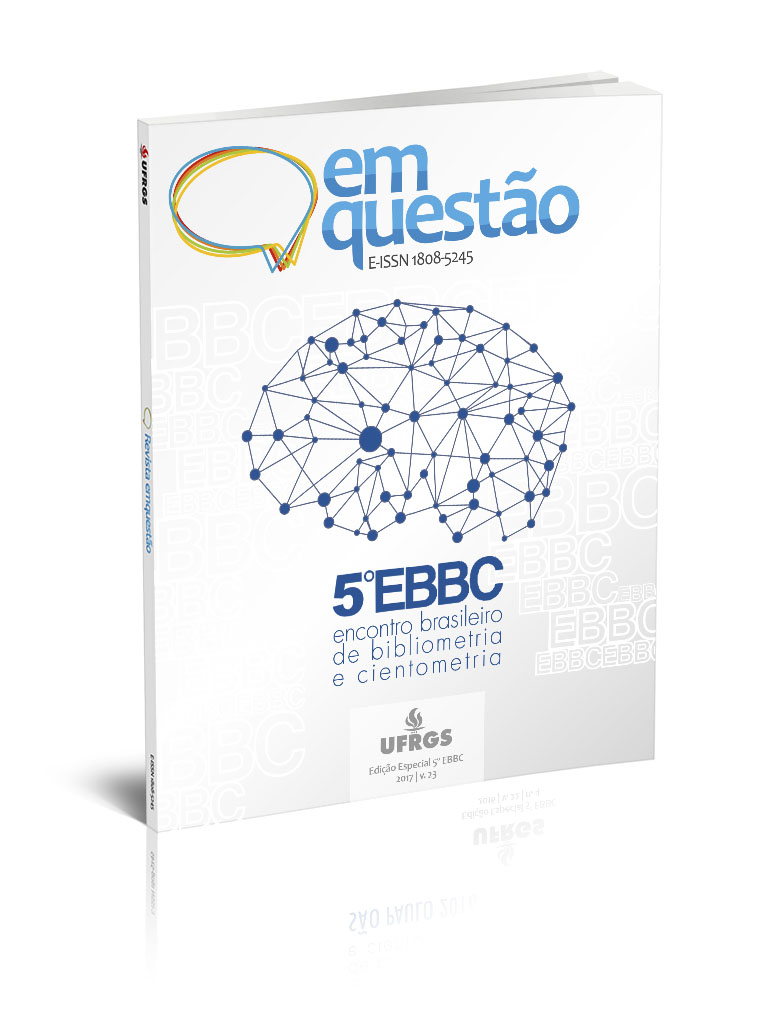The problem of standardization of authors’ affiliations in the Web of Science database: the Embrapa case and its solution
DOI:
https://doi.org/10.19132/1808-5245230.74-93Keywords:
Affiliation. Standardization. Embrapa. Web of Science. Communication policy.Abstract
Scientific and technological production is essential in the innovation process of a country or scientific institution. However, bibliometric evaluation of this performance has been facing for many years a major challenge: the lack of accuracy of the information recorded in scientific documents and databases. This article has as main objective to verify to what extent this problem still persists in Brazilian scientific production, through literature and bibliometric investigations. In this second case, it was done, for example, a basic study on the visibility of the Brazilian Agricultural Research Corporation in the database Web of Science .The results showed a high incidence of standardization issues, reflected in the percentage of 11.93% of variations related to the original name and acronym Embrapa. Given this result, the institution issued an internal normative resolution regulating the membership of its employees in national and international publications.Downloads
References
BOURNE, Charles Percy. Frequency and impact of spelling errors in bibliographic databases. Information Processing & Management, Elmsford, NY, v. 13, n. 1, p. 1-12, 1977.
BRASIL. Ministério da Ciência e Tecnologia. Indicadores Nacionais de Ciência, Tecnologia e Inovação. Disponível em: <http://www.mcti.gov.br/indicadores>. Acesso em: 18 mai. 2016.
EMBRAPA. Resolução Normativa n°4. Boletim de Comunicações Administrativas. Brasília: Embrapa, 2016.
EMBRAPA. Manual de editoração. Disponível em: <http://manual.sct.embrapa.br/editorial/default.jsp>. Acesso em: 18 mai. 2016.
EMBRAPA. Política de Comunicação. Brasília: Embrapa Informação Tecnológica, 2002. Disponível em: <http://www.youblisher.com/p/123990-Politica-de-Comunicacao/>. Acesso em: 18 mai. 2016.
GOIS, Antônio. ITA lidera em produtividade científica. Folha de S. Paulo, São Paulo, 14 jan. 2008. Caderno Ciência, A10.
GREGOLIN, José Ângelo Rodrigues et al. Análise da produção científica a partir de indicadores bibliográficos. In: LANDI, Francisco Romeu; GUSMÃO, Regina (Coord.). Indicadores de ciência, tecnologia e inovação em São Paulo 2004. São Paulo: FAPESP, 2005. 2 v. Disponível em: <http://www.fapesp.br/2060>. Acesso em: 18 mai.2016.
HOOD, William; WILSON, Concepción. Informetric studies using databases: opportunities and challenges. Scientometrics, Dordrecht, v. 58, n. 3, p. 587-608, 2003.
LETA, Jacqueline; CRUZ, Carlos Henrique de Brito. A produção científica brasileira. In: VIOTTI, Eduardo. B.; MACEDO, Mariano de M. (Orgs.). Indicadores de ciência, tecnologia e inovação no Brasil. Campinas: Editora da Unicamp, 2003. p. 123-168.
PENTEADO FILHO, Roberto de Camargo. Création de systèmes d'intelligence dans une organisation de recherche et développement avec la scientométrie et la médiamétrie. 2006. 328 p. Tese (Doutorado) - Université du Sud, Toulon Var, Toulon, 2006.
PENTEADO FILHO, Roberto de Camargo; FONSECA JÚNIOR, Wilson Corrêa da; AVILA, Antonio Flavio Dias. Perfil da produção científica da Embrapa entre 2007 e 2015: oportunidades e desafios. Documentos (Embrapa SGI) (1679-4680), v. 17, 2016. No prelo.
TAŞKIN, Zehra; AL, Umut. Standardization problem of author affiliations in citation indexes. Scientometrics, Dordrecht, v. 98, n. 1, p. 347-368, jan. 2014.
Downloads
Published
How to Cite
Issue
Section
License
Copyright (c) 2017 Em Questão

This work is licensed under a Creative Commons Attribution 4.0 International License.
Authors who publish with this journal agree to the following terms:
Authors will keep their copyright and grant the journal with the right of first publication, the work licensed under License Creative Commons Attribution (CC BY 4.0), which allows for the sharing of work and the recognition of authorship.
Authors can take on additional contracts separately for non-exclusive distribution of the version of the work published in this journal, such as publishing in an institutional repository, acknowledging its initial publication in this journal.
The articles are open access and free. In accordance with the license, you must give appropriate credit, provide a link to the license, and indicate if changes were made. You may not apply legal terms or technological measures that legally restrict others from doing anything the license permits.













